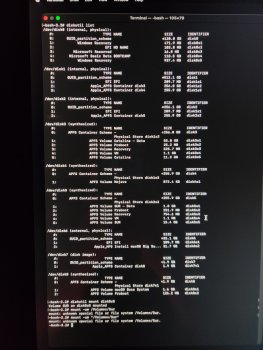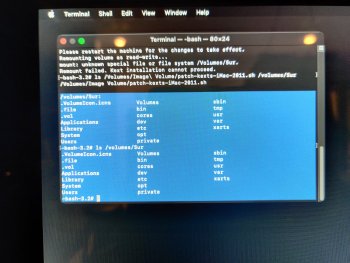Hi everyone,
Newbie here on the forum, but not new to beta testing and the such (also a super computer nerd!).
I have a iMac late 2013 that I just installed from scratch with the latest beta and Barry's Micropatcher (in fact I'm posting from inside the beta right now). Haven't tested everything yet, but it worked as expected after I got past the same issue someone else had on here a few pages back - the NVRAM error "nvram error getting variable -boot-args (iokit/common) data was not found". I believe it was in post #3,805.
When I first tried to install this morning, I kept running into the above error message after I created the bootable USB drive and patched it using Barry's Micropatcher and then booted from the USB drive. The next instructions to run 'set-vars.sh' from terminal is where I had issues. I kept getting the "nvram error getting variable -boot-args (iokit/common) data was not found", even though it successfully disabled SIP, etc. Thinking that I could just ignore this, I tried to install MacOS Big Sur Beta (Beta 6) and it kept giving me the Forbidden symbol after it rebooted the first time (having dowloaded the additional components).
I tried to understand what everyone else on here has been commenting in this thread, but it wasn't helping my issue, so I searched the interwebs for an answer. Not sure if I'm allowed to post what I found on here, but what I found is that there is a step that might need to be done in-between patching the USB installer and booting from it. Essentially, there was an addtional step of booting into Recovery Mode (NOT from the USB drive), opening terminal and running the following command:
Then, restart and boot from the USB installer, open Terminal again and run -
So, apparently the 'no_compact_check' is crucial to prevent the 'Forbidden' symbol coming up after you start the install and this command HAS to be run from regular MacOS Recovery and NOT from the USB installer. As I understand it, Beta 6 broke the 'NVRAM boot-args' command that is supposed built into Barry's Micropatcher (though I could be wrong about this), hence why you have to run this command before booting from the USB installer.
Hope this helps Will350 and anyone else that's had this issue recently!
Newbie here on the forum, but not new to beta testing and the such (also a super computer nerd!).
I have a iMac late 2013 that I just installed from scratch with the latest beta and Barry's Micropatcher (in fact I'm posting from inside the beta right now). Haven't tested everything yet, but it worked as expected after I got past the same issue someone else had on here a few pages back - the NVRAM error "nvram error getting variable -boot-args (iokit/common) data was not found". I believe it was in post #3,805.
When I first tried to install this morning, I kept running into the above error message after I created the bootable USB drive and patched it using Barry's Micropatcher and then booted from the USB drive. The next instructions to run 'set-vars.sh' from terminal is where I had issues. I kept getting the "nvram error getting variable -boot-args (iokit/common) data was not found", even though it successfully disabled SIP, etc. Thinking that I could just ignore this, I tried to install MacOS Big Sur Beta (Beta 6) and it kept giving me the Forbidden symbol after it rebooted the first time (having dowloaded the additional components).
I tried to understand what everyone else on here has been commenting in this thread, but it wasn't helping my issue, so I searched the interwebs for an answer. Not sure if I'm allowed to post what I found on here, but what I found is that there is a step that might need to be done in-between patching the USB installer and booting from it. Essentially, there was an addtional step of booting into Recovery Mode (NOT from the USB drive), opening terminal and running the following command:
nvram boot-args=-no_compact_check
Then, restart and boot from the USB installer, open Terminal again and run -
. Then, install MacOS Big Sur and it should restart and continue as expected after downloading the additional components./Volumes/Image\ Volume/set-vars.sh
So, apparently the 'no_compact_check' is crucial to prevent the 'Forbidden' symbol coming up after you start the install and this command HAS to be run from regular MacOS Recovery and NOT from the USB installer. As I understand it, Beta 6 broke the 'NVRAM boot-args' command that is supposed built into Barry's Micropatcher (though I could be wrong about this), hence why you have to run this command before booting from the USB installer.
Hope this helps Will350 and anyone else that's had this issue recently!




